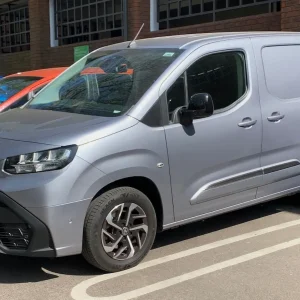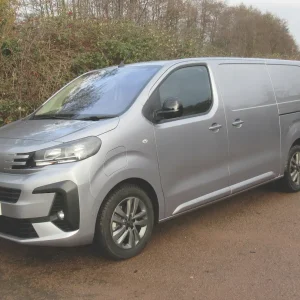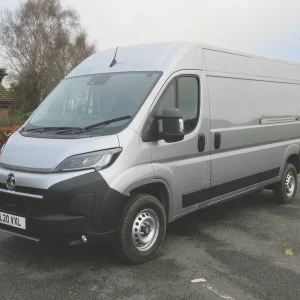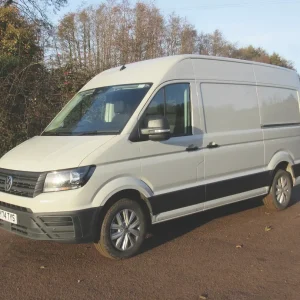The Vauxhall Vivaro may share a burgeoning medium-van platform alongside its Stellantis brand stablemates the Citroën Dispatch, Peugeot Expert and Fiat Professional Scudo as well as the Toyota Proace, as part of a third-party arrangement, but it is the Vauxhall van that leads the charge in the UK. With its reputation as a treasured national brand and a dealer network stretching the length and breadth of the land – including more than 60 Van Business Centres and a competitive warranty of three years/100,000 miles with service intervals of 30,000 miles – it is no surprise that the Vivaro is the most popular of these Stellantis-built vans in the domestic market.
My top of the range Elite double cab came with a wealth of driver-assistance features, such as lane keep assist, traffic sign recognition, drowsiness alert, adaptive cruise control and autonomous emergency braking. Blindspot sensors and a rear-view camera were also part of the deal. A multimedia 7in touchscreen delivered phone integration with Apple Carplay and Android Auto. The upgraded satnav purported to supply live traffic information (I was not convinced it did) as well as direct connection with roadside assistance and emergency call. Happily, I did not need to call upon the latter two facilities.
Unfortunately the satnav did not take account of recent road closures and traffic controlling measures taken during the Covid-19 lockdowns and nor did it like finding destinations via the input of a postcode, which meant I had to key in town and street names instead.
My first few weeks with the Vivaro were mainly spent driving in the city and for a large, long-wheelbase van over five metres in length it proved to be manoeuvrable and easy to manage.
A roof height of 1,935mm should ensure the Vivaro can safely negotiate most car park overhead barriers without mishap but caution is still advised, as a narrowly avoided close encounter with a 1.8m barrier at the Gatwick North short term car park proved.
The Vivaro Elite’s cabin is generally comfortable, if a little cramped. Reach and height-adjustable power steering takes the strain out of urban driving and a six-way adjustable driver’s seat with adjustable lumbar support makes it easy to find the most relaxing position.
An efficient stop/start system cuts out the engine when stationary and I was impressed by the head-up display in the driver’s eyeline, which allows you to keep your eyes on the road while monitoring speed and satnav directions, for example.
The Vivaro’s driving position, in common with all the other vans built on the same Stellantis platform, is slightly off centre and the dashboard controls are poorly illuminated at night. Storage facilities are plentiful although some of the provisions are not overly practical.
The 2.0L 150hp engine is well suited to higher speed long trips out on the open road and combines nicely with sharp handling. External noise is unobtrusive and ride quality is decent, as is build quality, with no unexplained rattles or squeaks to disturb the peace and all components sturdily put together. Adaptive cruise control takes much of the strain out of motorway driving and aids safety by maintaining a safe distance from the vehicle in front.
A full-height bulkhead protects the cabin from anything that may come adrift in the load area while an excellent reversing camera and all-round sensors make tight manoeuvres less hazardous. Other increasingly common but nonetheless laudable safety features include lane departure warning, side blind spot alert, forward collision alert with automatic emergency braking and pedestrian detection, driver drowsiness warning and speed sign recognition.
With fairly frugal fuel consumption thrown into the mix the Vivaro double cab Elite is a strong all-round performer capable of holding its own with the best in class. Backed up by Vauxhall’s strong support network, it is worthy of consideration.
End-of-term report
Desirability = 4/5
A sophisticated, refined medium-sized van well equipped to thrive in the most competitive market sector.
Cabin = 3/5
Generally comfortable but let down by some impractical storage facilities and an odd driving position.
Driving = 4/5
A responsive engine combines with sharp handling and decent levels of comfort.
Safety = 4/5
The Vivaro Elite comes with a comprehensive range of ADAS and safety kit.
Fuel economy = 4/5
Averaged slightly above the official combined figure.
Build quality = 4/5
Reassuringly solid with no worrying squeaks or rattles.
Overall score = 77%
Vauxhall Vivaro doublecab Elite 3100 L2H1 2.0 150hp
Mileage 1,355mls
Official combined fuel economy 31.8mpg
Our average consumption 33.9mpg
Price range (ex VAT) £24,378-£30,518
Price (ex VAT) £30,518
Warranty 3yrs/100,000mls
Service intervals 30,000mls
Load length 2,365mm
Load width (min/max) 1,258mm/1,636mm
Load bay height 1,396mm
Load volume 4.0m3
Gross payload 1,245kg
Engine size/power 1,997cc/150hp
Gearbox 6-spd manual
CO2 143g/km
5th Report
With the clock ticking down on the internal combustion engine Vauxhall has moved quickly to get its electric Vivaro-e into the market place ahead of many competitors (notably arch-rival Ford) and has also got a Vivaro-e Hydrogen lined up for further down the evolutionary line.
Once these technologies move into the mainstream, and the electric Vivaro has already been doing brisk business with large fleets such as British Gas and Mitie plus SMEs like fruit and vegetable supplier Riverford, then the main concern for operators is likely to be the efficiency of the charging infrastructure and whether it can keep their vans sufficiently charged to complete their missions without increasing downtime.
In the meantime, however, most businesses still rely on diesel, which means they must not only be wary of low-emission zones but, with the cost of filling up at the pumps soaring, also work to keep fuel consumption as low as possible.
In terms of economy, my double- cab Vivaro has performed respectably enough, its mpg has been boosted by a couple of long trips out of town but it has not suffered dramatically from a return to urban driving and is averaging at just under 34mpg. While in no way obsessive about adhering to an eco-friendly driving style, I do try to avoid excessive braking and sharp acceleration and keeping the van in the gear where the engine is happiest.
The Vivaro’s efficient stop/start system and the fact I have more often carried bulky rather than heavy loads in the back has also helped keep consumption under control.
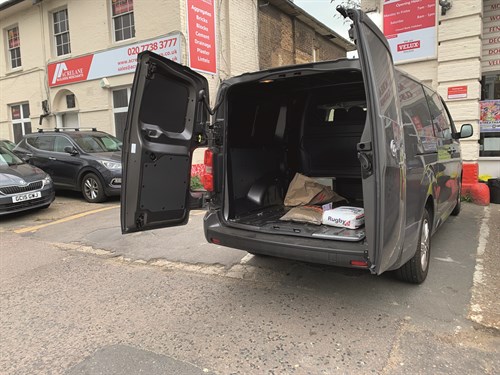
It is a compliment to the refinement and soundproofing installed in the Vivaro’s cabin that engine noise rarely intrudes into the interior because from outside the van it has to be said the 2.0L turbocharged diesel is not the quietest engine around. The good quality of the Multimedia Navi Pro sound system, featuring four speakers within the cabin, also masks exterior noise.
The second row of passenger seats in a crew van eats into load space, so choosing the double-cab based on the LWB Vivaro compensates for this loss of cargo capacity. But at just over 5.3m, it is a long vehicle and dextrous skills can be required when negotiating urban car parks and on-street parking spaces. At slightly over 1.9m high, drivers should be reassured that the van can safely fit into most underground car parks.
With the two rear side doors used for back seat passengers, access to the 4.0m3 load bay is via twin doors at the back, which can be pushed through 90º, or through 180º if you release the stays. Six tie-down rings are fitted on the load floor to secure cargo.
Report card: Fuel economy = 4/5
The Vivaro double cab is averaging slightly above the official combined mpg figure.
Vauxhall Vivaro doublecab Elite 3100 L2H1 2.0 150hp
Mileage 1,355mls
Official combined fuel economy 31.8mpg
Our average consumption 33.9mpg
Price range (ex VAT) £24,378-£30,518
Price (ex VAT) £30,518
Warranty 3yrs/100,000mls
Service intervals 30,000mls
Load length 2,365mm
Load width (min/max) 1,258mm/1,636mm
Load bay height 1,396mm
Load volume 4.0m3
Gross payload 1,245kg
Engine size/power 1,997cc/150hp
Gearbox 6-spd manual
CO2 143g/km
4th Report
The days when ADAS (advanced driver assistance systems) and safety kit were at the bottom of the list for fleet managers specifying vans for their staff are thankfully becoming consigned to history, although recent research by the Thatcham Research Centre in partnership with Euro NCAP made uncomfortable reading for some manufacturers who, it was revealed, were fitting far fewer safety aids to their light commercials than to their passenger cars.
Although the Vauxhall Vivaro performed reasonably well in the tests, receiving the second top silver certification, it is to be hoped the research will encourage manufacturers to focus even more closely on this critical area.
Our Vivaro Elite is pretty well stocked with ADAS features, but I have come across a couple of bugbears as a driver. The first is that the rear-view mirror has been left in place despite the presence of the full-height bulkhead and non-glazed rear doors rendering it a non-functional distraction.
While I, of course, applaud the fitting of the bulkhead in protecting the double cab from any items that may come loose in the load area, why not remove the mirror too?
The side mirrors on which van drivers rely heavily could also stand to be a tad larger but this shortcoming is amply mitigated for by the excellent ‘panoramic’ reversing camera and all round sensors on my van, as well as by the inclusion of lane departure warning, which alerts the driver if they stray out of lane without indicating, and by side blind spot alert that flashes an orange light in the appropriate side mirror if a vehicle is approaching unseen on either side.
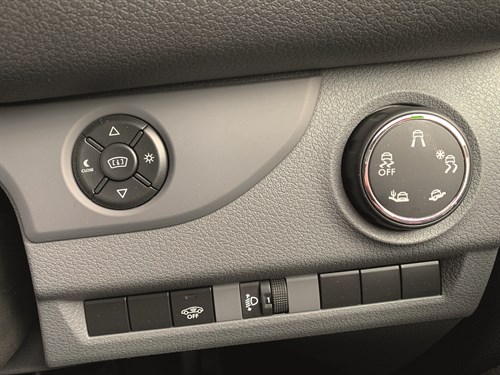
I have previously praised the Vivaro’s semi-adaptive cruise control for taking the strain out of long motorway trips but a drawback is that the buttons and finger wheel for activating and deactivating the system are often hidden behind one of the steering wheel struts on the steering column when driving, which can make them fiddly to use.
While its inclusion is laudable in helping to keep the driver within legal limits, the speed sign recognition chime can become a little irritating on inner-city routes when the speed cameras come thick and fast.
Overall, however, the ADAS provisions are impressive, one such is the head-up display, which the driver can view while keeping eyes on the road, I particularly like the dial on the dashboard that enables the driver to position the display in the best position to see it. Also included are forward collision alert with automatic emergency braking and pedestrian detection, driver drowsiness warning system, driver and front passenger’s curtain and side-impact airbags, hill start assist, selective door locking, rain-sensitive windscreen wipers, automatic lighting control and front cornering lights.
For light off-roading assignments, my van also has the Intelligrip traction-aid package as a £660, excluding VAT, option, which includes modes for driving in snow, mud or sand.
Report card: Safety = 4/5
The Vivaro Elite comes with a comprehensive range of ADAS and safety kit.
Vauxhall Vivaro doublecab Elite 3100 L2H1 2.0 150hp
Mileage 1,193mls
Official combined fuel economy 31.8mpg
Our average consumption 33.9mpg
Price range (ex VAT) £24,378-£30,518
Price (ex VAT) £30,518
Warranty 3yrs/100,000mls
Service intervals 30,000mls
Load length 2,365mm
Load width (min/max) 1,258mm/1,636mm
Load bay height 1,396mm
Load volume 4.0m3
Gross payload 1,245kg
Engine size/power 1,997cc/150hp
Gearbox 6-spd manual
CO2 143g/km
3rd Report
Having spent several weeks putting the Vivaro through its paces in a city setting, it was good to finally get some miles under its wheels in a variety of extra-urban environments, taking in motorways, A and B roads, country lanes and even unpaved rural tracks.
One of my concerns was whether the slightly off-centre driving position mentioned in my last report would prove to be an issue on a long journey but, thankfully, I arrived in rural Gloucestershire after several hours behind the wheel, during a drive extended by ubiquitous roadworks and a motorway junction closure, without any new and unwelcome aches and strains. This is testament to most other aspects of the cab being well designed for comfort.
The seats are firmish (a good thing) and supportive, while the gear stick is within easy reach and at a good height for the driver, although the gear knob itself is peculiarly and unnecessarily bulbous, in my opinion.
The six-way adjustable driver’s seat provides ample options to find your best driving position and a lumbar adjustment wheel and armrest (although just the one) further boost comfort when you’re spending a long time in the saddle. A padded head restraint also helps, and is a feature included for front and rear seat passengers. Those in the back get three individually contoured seats and a 12V socket but, disappointingly, these seats are not equipped with child isofix mountings.
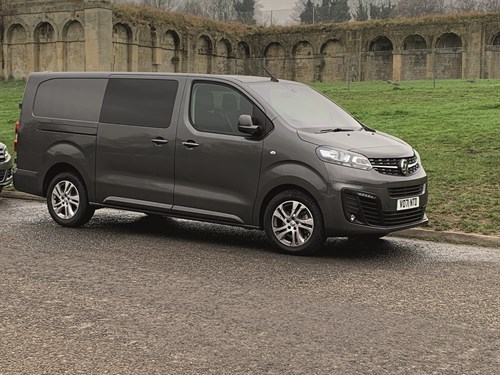
Getting back to the driver, it goes without saying that the steering wheel is adjustable for reach and rake. This facilitates finding the most comfortable steering position. Buttons for operating audio and a smartphone – once it is paired via Bluetooth – are mounted on the steering column, as are the controls for the semi-adaptive cruise control. This not only makes for a more relaxing drive on long motorway stretches, but more importantly increases safety by using engine braking to keep a set following distance to the vehicle ahead. The system can be switched on at speeds of between 25mph and 93mph. If the selected following distance cannot be maintained because the vehicle in front is moving too slowly, a warning chime sounds and a message appears in the driver information centre, located in the dashboard, alerting the driver to take back control of the van.
Once given its head out on the open road the 150hp engine is impressively responsive with a moderate load in the back and reasonably quiet. Road and wind noise are also well suppressed in the cab and the ride quality proved to be smooth on a variety of road surfaces.
While the EAT8 automatic might be the transmission of choice for the Vivaro, the top cruising gear of the six-speed manual gearbox is well matched to long drives on faster routes, although when frequently moving up and down the cogs in traffic or on winding country roads it is adequate rather than outstanding, particularly in comparison to the likes of the Ford Transit Custom or Volkswagen Transporter. More impressive is the Vivaro’s reassuringly sharp handling when pressed hard into corners. The L2 double-cab is a fairly large van but, to its credit, it does not feel like one to drive.
Report card: Driving = 4/5
A responsive engine combines with sharp handling and decent levels of in-cab comfort.
Vauxhall Vivaro doublecab Elite 3100 L2H1 2.0 150hp
Mileage 842mls
Official combined fuel economy 31.8mpg
Our average consumption 33.1mpg
Price range (ex VAT) £24,378-£30,518
Price (ex VAT) £30,518
Warranty 3yrs/100,000mls
Service intervals 30,000mls
Load length 2,365mm
Load width (min/max) 1,258mm/1,636mm
Load bay height 1,396mm
Load volume 4.0m3
Gross payload 1,245kg
Engine size/power 1,997cc/150hp
Gearbox 6-spd manual
CO2 143g/km
2nd Report
My first few weeks with the Vivaro double cab have been spent in urban environments and on the whole it is proving to be something of a manoeuvrable and civilised van about town.
A reasonably quiet engine (although the 2.0l tested here is noisier than the 1.5 in the range) means it goes about its business discreetly and a roof height of 1.9m makes nearly all city car parks easily accessible.
The L2 double cab is 5,309mm long but a wall to wall turning circle of 12.9m means it is passably nimble in tight situations. By way of comparison, this is fractionally wider than the 12.8m turning circle of the Vauxhall van’s arch rival, the Ford Transit Custom Limited double-can in van.
Reach and height adjustable hydraulic steering with electrical power assistance takes the strain out of the frequent changes of direction that are part and parcel of city driving and an efficient stop/start system obediently cuts off the engine at junctions and traffic lights.
The suspension employs MacPherson struts and an anti-roll bar at the front along with coil springs and gas pressure dampers at the rear. The result is a ride that feels well-supported but softish and comfortable enough when negotiating speed humps and, increasingly the potholes that populate London’s streets.
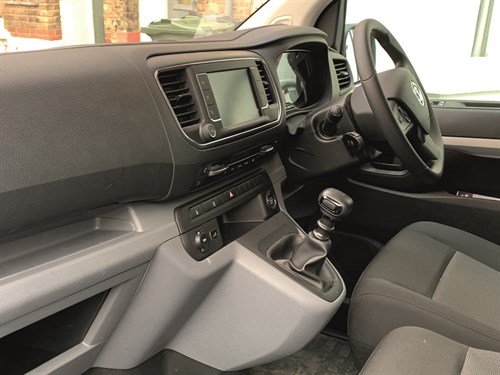
An interior bonus with the flagship Elite specification Vivaro is the head up display, which allows the driver to keep their eyes on the road while checking speed and satnav directions, for example. On other trim levels the head up display is available as a £990 option, and that’s excluding VAT.
The driver’s seat is six-way adjustable and comes with adjustable lumbar support and an armrest, which should make it easy enough to find the best driving position. A quirk of the Vivaro however, and also of the medium vans built on the same platform: the Citroen Dispatch, Peugeot Expert and Toyota Proace, is the off-centre driving position that places the steering wheel to the left of the seat and the pedals to the right. This is more than a little disconcerting at first although it has to be said you do get used to it. I have suffered no ill effects over the short distances I have covered so far but suspect it may be a different and less comfortable story once I have undertaken longer journeys in such an ergonomically-compromised driving position.
Another downside is that the cabin can feel cramped and dark due to small windows and a high dashboard. At night it is difficult to see the buttons and dials on the dashboard as they are poorly lit.
Turning to storage, the glove box is a decent size but not lockable and sits above a cubby hole for odds and ends. The door bins are generously proportioned and there is a lidded tray on top of the dashboard. The space below the 7in touchscreen though, is too small to hold a modern smartphone and some of the other storage surfaces are too narrow and shallow to be of much practical use.
Finally, as is so often the case with front bench seats, the moulding for the gearstick bows out into the cabin, encroaching into the middle-seat passenger’s legroom (obstructing the right knee, to be precise), thus rendering unfeasible anything other than short journeys with three in the front.
Report card: Cabin = 3/5
Generally comfortable but let down by some impractical storage facilities and an odd driving position.
Vauxhall Vivaro doublecab Elite 3100 L2H1 2.0 150hp
Mileage 555mls
Official combined fuel economy 31.8mpg
Our average consumption 31.3mpg
Price range (ex VAT) £24,378-£30,518
Price (ex VAT) £30,518
Warranty 3yrs/100,000mls
Service intervals 30,000mls
Load length 2,365mm
Load width (min/max) 1,258mm/1,636mm
Load bay height 1,396mm
Load volume 4.0m3
Gross payload 1,245kg
Engine size/power 1,997cc/150hp
Gearbox 6-spd manual
CO2 143g/km
1st Report
Vauxhall has long – and proudly – promoted its top selling van, the medium-sized Vivaro, as being ‘Made in Britain’ due to it being assembled at its historic plant in Luton.
The Vivaro, however, built its reputation as a rebadged take on the Renault Trafic over a period of almost two decades from 2001, and while the Union Jack stamp remains on the back of the Luton-built model, since 2019 the Vivaro has been based on the products of another French manufacturer, PSA Peugeot-Citroen, as Vauxhall’s version of the Peugeot Expert and Citroen Dispatch. The switch between Gallic parents became inevitable following PSA’s acquisition of Opel/Vauxhall in 2017.
All three brands now belong to the enlarged Stellantis group, which has partnered with Toyota to enable the Japanese manufacturer to share its medium van blueprint for its Proace.
All four models share the same engines and all four are now available with electric drivetrains.
So that’s enough of the history lesson. Suffice to say that customers’ preference for one of these highly competent vans over the others is likely to come down to their relationship with the brand and the proximity of its dealerships and workshops to their businesses. With a nationwide retail network, including around 60 Van Business Centres, Vauxhall is well positioned in this regard.
Other considerations will be warranties, service intervals and residual values.
Vauxhall offers a warranty of three years/100,000 miles on the Vivaro with service intervals of 30,000 miles or two years – whichever comes sooner. Citroen and Peugeot offer the same warranty on the Dispatch and Expert but service intervals are 25,000 miles.
Toyota, meanwhile, provides a five year/100,000 mile warranty with gaps between services of 25,000 miles. The Proace also tends to deliver slightly higher residual values.
The third-generation Vivaro is available in two lengths – 4.95m and 5.30m – and three bodystyles – panel van, crew cab and platform chassis. It has a maximum cargo capacity of 6.6m3, and a payload of up to 1,400kg – 200kg more than the outgoing, Renault-based model.
The maximum trailer load has also increased, from 2,000kg to 2,500kg.
Engine options are 1.5l diesels with 100hp or 120hp, and 2.0l diesels with 120hp, 150hp and 180hp.
A driver head-up display is offered, as are driver assistance systems including lane keep assist, traffic sign recognition, drowsiness alert, adaptive cruise control, forward collision alert and autonomous emergency braking. Blindspot sensors and a rear-view camera are also part of the package. A multimedia 7.0in touchscreen features phone integration with Apple Carplay and Android Auto, while the upgraded Multimedia Navi system features European navigation with 3D view, along with live traffic information, direct connection with roadside assistance and emergency call.
The latest addition to What Van?’s long-term test fleet is a Vivaro doublecab Elite 3100 L2H1 powered by the 2.0l engine with 150hp output.
The Vivaro range comes in four trim levels: Edition; Dynamic; Sportive; Elite and specification levels are high across the line-up. The entry-level grade, for example, gets cruise control with speed limiter, Bluetooth and near- and off-side sliding doors, which make life easier for passengers in a doublecab.
In addition to Sportive, the Elite gets features such as Multimedia Navi Pro satnav, lane departure warning, speed sign recognition with intelligent speed adaptation, side blind spot alert, semi-adaptive cruise control, a rear-view camera and 17in alloy wheels.
Report card: Desirability = 4/5
The Vivaro Elite is a sophisticated, refined van well equipped to thrive in the most competitive market sector.
Vauxhall Vivaro doublecab Elite 3100 L2H1 2.0 150hp
Mileage 409 mls
Official combined fuel economy 31.8mpg
Our average consumption 31.3mpg
Price range (ex VAT) £24,378-£30,518
Price (ex VAT) £30,518
Warranty 3yrs/100,000mls
Service intervals 30,000mls
Load length 2,365mm
Load width (min/max) 1,258mm/1,636mm
Load bay height 1,396mm
Load volume 4.0m3
Gross payload 1,245kg
Engine size/power 1,997cc/150hp
Gearbox 6-spd manual
CO2 143g/km

